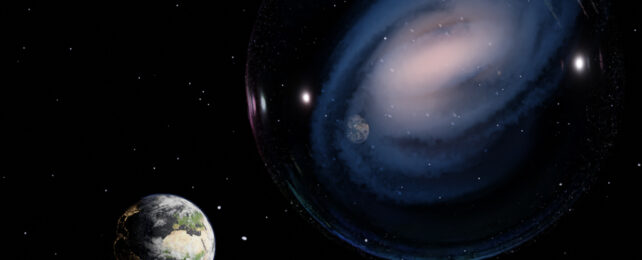Far, far away, back when the Universe was barely a couple billion years old, there floats a galaxy eerily similar to our own. And astronomers aren't quite sure what to make of it.
The distant formation known as ceers-2112 was recently identified by an international team of researchers using an analysis of images taken by the James Webb Space Telescope (JWST) Near Infrared Camera.
While an initial inspection of the pictures failed to reveal much more than a hazy blob, further investigation using a range of wavelengths added to by Hubble showed the ancient system for what it was – a complex, barred spiral structure just like the Milky Way, if somewhat smaller.
Galaxies come in all manner of shapes, sizes, and luminosities that betray their evolutionary history. Some are large and blobby, some small and irregular, some gigantic and stretched out.
Then there are those like ours that swirl, with stars and gas concentrated in radiating lines that curve like cosmic ribbons trailing from a spinning gymnast.
Though a variety of factors influence a galaxy's shape, from monolithic collisions to the crowding of neighbors, it's long been believed that complex shapes take time. As a general rule of thumb, barred spiral galaxies like the Milky Way aren't thought to exist any earlier than around 8 billion years ago.
Yet a measure of ceers-2112's stretched light suggests it was already looking rather fancy a mere 2 billion years after the Big Bang.
Though the galaxy is still too faint to see details of its spiraling arms, the detection of a thickened bar through its center is enough to convince astronomers ceers-2112 is remarkably well-developed for its age.
"Nearly all bars are found in spiral galaxies," says Alexander de la Vega, an astronomer at the University of California, Riverside.
"The bar in ceers-2112 suggests that galaxies matured and became ordered much faster than we previously thought, which means some aspects of our theories of galaxy formation and evolution need revision."
Galaxies are more or less vast concentrations of dust and gas that come together under gravity. Some of that gravity is provided by the debris itself, with a significant proportion believed to be the result of dark matter.
Where enough material collects in any one spot, nuclear fusion can spark, giving us stars and their less-sparkly offspring, planets. Meanwhile, the sum of inertia contained in the swirling dust and zooming suns can make the infant galaxy turn.
The mix of forces – in the form of angular momentum, gravity's attraction, and inertia of falling masses – may eventually flatten the galactic blob into a disc shape. With some stars pulled into less-circular paths than others, aberrations in orbits can slowly magnify, affecting other stellar journeys to build into distinct patterns we see as bars.
In turn, structures like bars or nearby galaxies can exert their influence over the spread of objects in a galaxy, producing vast ripples that appear as spirals as the galaxy turns.
As imagined, the molding of a galaxy should require sustained forces acting over long periods. Yet the discovery of ceers-2112 could mean a rethink on just what is required to turn a nebulous blob into a majestic whirl.
"In the past, when the Universe was very young, galaxies were unstable and chaotic. It was thought that bars could not form or last long in galaxies in the early Universe," says de la Vega.
The finding joins an array of recent unexpected discoveries concerning the conditions of the early Universe, of galaxies that blaze too brightly, or precocious black holes that grow too quickly.
As the JWST continues to deliver stunning images of the cosmos in its infancy, we'll no doubt learn not just how galaxies like ceers-2112 came into existence, but how our very own galaxy came to look as stunning as it does today.
This research was published in Nature.
